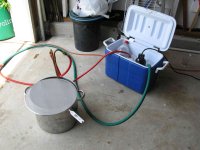C
crwright2020
I do not have a wort chiller yet. The way I cool my wort now is to brew a partial boil, pour the wort into cold water and cool in the sink with cold water around the the primary container.
As you know this can take a while and can make for a long night.
Is there any adverse affects if you put ice in the hot wort to help with the cooling?
As you know this can take a while and can make for a long night.
Is there any adverse affects if you put ice in the hot wort to help with the cooling?

